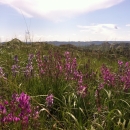About Us
UL Bend National Wildlife Refuge is part of a complex of refuges managed by Charles M. Russell National Wildlife Refuge from the headquarters station in Lewistown, Montana. Because the UL Bend Refuge lies within the boundary area of the Charles M. Russell Refuge, essentially they are managed as one unit even though they were established through different authorities and for different purposes.
UL Bend Refuge was established through the Migratory Bird Conservation Commission on February 7, 1967 “for use as an inviolate sanctuary, or for any other management purpose, for migratory birds”. In 1976, Congress designated 20,819 acres of the refuge as the UL Bend Wilderness. Within this designated wilderness area wilderness area
Wilderness areas are places untamed by humans. The Wilderness Act of 1964 allows Congress to designate wilderness areas for protection to ensure that America's pristine wild lands will not disappear. Wilderness areas can be part of national wildlife refuges, national parks, national forests or public lands managed by the Bureau of Land Management.
Learn more about wilderness area , visitors can expect to experience undeveloped land that has kept its primeval character providing an opportunity for solitude and unconfined recreation.
Our Mission
The mission of the National Wildlife Refuge System is to administer a national network of lands and waters for the conservation, management and, where appropriate, restoration of the fish, wildlife and plant resources and their habitats within the United States for the benefit of present and future generations of Americans.
Our History
UL Bend National Wildlife Refuge was established through the Migratory Bird Conservation Commission on February 7, 1967. On March 25, 1969, Public Land Order 4588 designated the UL Bend National Wildlife Refuge on about 56,090 acres. The order defined the Refuge’s purpose: “for use as an inviolate sanctuary, or for any other management purpose, for migratory birds”. Early development plans called for the construction of a series of dikes in the interior of the Refuge to convert uplands to aquatic habitat for waterfowl. Some attempts were made toward this development, but these were never completed, and the plans were abandoned. Although it was primarily established for the development and management of waterfowl, other wildlife that use refuge habitat includes the endangered black-footed ferret, elk, deer, pronghorn, migratory birds, and other prairie species.
Bison, elk, deer, and pronghorn historically used the crossing at this huge bend in the Missouri River, and the abundance of game attracted Native Americans including the Assiniboine, Gros Ventre, and the Blackfeet. Explorer Meriwether Lewis noted the following in his journal on May 21, 1805: “The Missouri in its course downward makes a suddon and extensive bend toward the south, to receive the Muscle shell river, the point of country thus formed tho’ high is still much lower than that surrounding it, thus forming a valley of wavey country which extends itself for a great distance in a Northerly direction; the soil is fertile, produces a fine turf of low grass and some herbs, also immence quantities of the Prickley pear, without a stick of timber of any description.” In 1896, Oren and Will Bachues established a ranch in the “Big Bend of the Missouri River.” The place became known as UL Bend after the ranch’s stock brand.
In 1976, Congress designated 20,819 acres of the refuge as the UL Bend Wilderness. Within this designated wilderness area wilderness area
Wilderness areas are places untamed by humans. The Wilderness Act of 1964 allows Congress to designate wilderness areas for protection to ensure that America's pristine wild lands will not disappear. Wilderness areas can be part of national wildlife refuges, national parks, national forests or public lands managed by the Bureau of Land Management.
Learn more about wilderness area , visitors can expect to experience undeveloped land that has kept its primeval character providing an opportunity for solitude and unconfined recreation.
Other Facilities in this Complex
This Refuge is managed as part of the Charles M. Russell Complex. A National Wildlife Refuge Complex is an administrative grouping of two or more refuges, wildlife management areas or other refuge conservation areas that are primarily managed from a central office location. Refuges are grouped into a complex structure because they occur in a similar ecological region, such as a watershed or specific habitat type, and have a related purpose and management needs. Typically, a project leader or complex manager oversees the general management of all refuges within the complex and refuge managers are responsible for operations at specific refuges. Supporting staff, composed of administrative, law enforcement, refuge manager, biological, fire, visitor services, and maintenance professionals, are centrally located and support all refuges within the complex.




